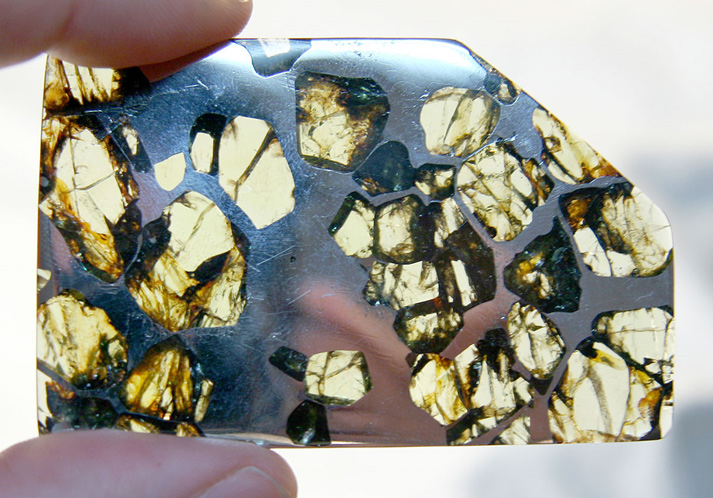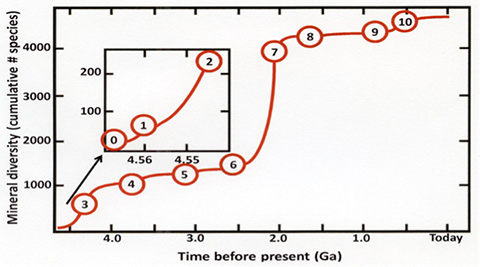
We know that life evolves, but did you know that minerals do, too?
Remarkably, one of the biggest drivers of mineral evolution… is life.
A mineral is simply an element or elements on the periodic table, arranged in a certain crystal structure. For instance, the hardest mineral, diamond, is formed of the element carbon.
One of the softest, graphite, is also formed of pure carbon, but it’s a different mineral because it has a different crystal structure.
When Earth formed, over 4.5 billion years ago, there were just 12 minerals, including diamond and graphite.
Over the next 2 billion years, plate tectonics began to act on mineral evolution.
Earth’s crust was subducted into the mantle, melted, remixed, and recycled, and the number of mineral species gradually increased to 1,500. And there it stopped…
Until life developed.
Early algae and phytoplankton converted huge volumes of carbon dioxide into oxygen.
This new oxygen-rich environment produced more than 2,500 new oxide and hydroxide mineral species.
Microbes then began to transform minerals chemically, and this added another 500 mineral species.
Multicell organisms evolved and interacted with existing minerals to build their exoskeletons, shells, bones, and teeth, in the process creating hundreds more mineral species.
Because Earth has plate tectonics and life, it now has over 5,000 minerals—10 times more than any other planet in the solar system.
Background
Synopsis: All of the naturally occurring chemical elements formed in the early days of the 13.8 billion-year-old universe, but only about a dozen minerals existed by the time that our solar system started accreting (once-separate parts growing together) about 4.6 billion years ago. Today, Earth has more than 5,000 minerals, and scientists recently determined that two-thirds of those could not have formed without the influence of life. Understanding the evolution of minerals on Earth helps us understand the evolution of minerals on other planets and moons in our solar system and beyond.
- A mineral is a combination of specific elements in a particular three-dimensional order, or crystalline lattice.
- There are 98 naturally occurring elements, and another 20 that have been synthesized in labs or nuclear reactors.
- Some very different minerals can have the same chemical formula of elements, just arranged in different crystalline structures—like diamond and graphite, or pyrite and marcasite. These polymorphs can result in remarkably different physical appearances and properties despite having identical chemistries.
- Minerals can crystallize from elements circulating in molten magma or lava, or they can precipitate when elements become supersaturated in solutions.
- Rocks are mixtures of mineral crystals or mineral grains of various sizes.
- Scientists have identified three eras of mineral evolution—from 12 initial minerals to today’s more than 5,000.
- The era of planetary accretion took place before Earth formed 4.55 million years ago. It started with just 12 minerals, which then increased to 60, and eventually to 250.
- Researchers hypothesize that the first mineral crystal to form was probably a microscopic form of diamond, since stars are carbon rich and diamond forms at the highest temperature of any known crystal.
- Our knowledge of this early period comes from the study of stony, or chondritic, meteorites, some of which carry the signature of the earliest interstellar material, including diamond, graphite, corundum (ruby, sapphire), and olivine (peridot)—a total of just 12 minerals.
- Chondrites contain chondrules—spherical droplets of molten material that formed by flash heating and cooling of interstellar dust during the formation of the sun. Minerals found along with chondrules in some chondrites increase the mineral count to about 60, including pyroxene and magnetite.
- Meteorites known as achondrites (which do not contain chondrules) provide details of the next evolutionary step. As gravitational pull caused chondrites to clump together into larger and larger bodies, those that grew to more than about 200 km (120 miles) in diameter began to heat up. Primitive minerals were subjected to aqueous and thermal alteration, resulting in the development of early micas, hydroxides, sulfates, and carbonates. This activity increased the number of minerals to about 250, including quartz, feldspar, and zircon.

- The era of crust and mantle reworking took place from 4.55 to 2.5 billion years ago in the Hadean and Archean Eons. During this period, new mineral species formed solely through physical and chemical alteration, increasing the number of minerals to 420, then 1,000, and finally 1,500 varieties.
- As planets coalesced up until about 4 billion years ago, the Hadean Eon ushered in differentiation of planetary bodies into their major layers, including denser metallic core, siliceous mantle, and less-dense basaltic crust. Earth’s core began to generate its magnetic field toward the end of this period. Volcanism and mantle degassing on Earth produced a primitive atmosphere and hydrosphere that interacted with crustal materials to form new clay minerals, evaporitic salts, and ice at the poles, increasing the mineral species count to around 420.
- At the end of the Hadean Eon, from 4 to 3.8 billion years ago, craters throughout the solar system record intense comet and asteroid bombardment possibly caused by orbital interactions of Jupiter and Saturn that sent Neptune through a belt of comets in the outer solar system, splitting them like billiards. Water-rich comets that impacted Earth may have provided much of the water on Earth and its neighbors. Very few rocks and minerals are preserved from the Hadean Eon.
- In the Archean Eon, Earth evolved beyond the other rocky planets in our solar system. In the early part of the eon, from 3.8 to 3.2 billion years ago, wet basalts partially melted, producing granitic magmas 10 percent more buoyant than the parent basalts. These melts rose upward to form a silica-rich cap at Earth’s surface, ultimately forming the cores of the continents. This process increased the mineral species on Earth to around 1,000. Granites are common on Earth’s surface but have not been found in abundance elsewhere in the solar system, making Earth the only planet with two types of surface crust: basaltic and granitic.
- By the late Archean, about 2.5 billion years ago, plate tectonics were well underway. Earth is the only planet in our solar system where we see continuous plate tectonics—the dynamic process by which wet crustal rocks are subducted into the mantle, ultimately recycling Earth’s surface. As surface rocks were driven into the higher-temperature and higher-pressure environment of the deep crust and mantle, widespread fluid-rock interactions occurred that created about 500 new high-pressure, hydrothermal, and metamorphic minerals, increasing Earth’s mineral diversity to around 1,500 species.
- Life emerged sometime during the Archean Eon as primitive microbes evolved on Earth’s surface in an atmosphere consisting primarily of carbon dioxide (CO2), methane (CH4), and water vapor (H2O). Huge volumes of unique banded iron formations and carbonates developed in primitive oceans, possibly through biological processes. Eventually, microscopic algae evolved to consume carbon dioxide and expel oxygen as a waste product of photosynthesis—leading to a dramatic change for Earth.
- The era of bio-mediated mineralogy began about 2.5 billion years ago with the “Great Oxidation Event” that took place at the start of the Proterozoic Eon. Over millions of years, primitive algae had multiplied, consuming carbon dioxide and expelling oxygen until atmospheric oxygen levels reached a tipping point. From this point through today, life and minerals helped each other evolve, ultimately tripling the number of minerals on Earth.
- The oxygen-rich atmosphere produced by living organisms caused oxidation of metals and minerals exposed on the surface. Nonequilibrium conditions mediated by life enabled elements to exist in multiple oxidation states, creating new elemental combinations for mineral formation. These conditions produced more than 2,000 new oxide and hydroxide minerals, including Earth’s valuable ore minerals.
- The first active manipulation of minerals by life came when microbes began to transform minerals chemically to produce energy. In about 500 million years, biological processes caused the number of minerals on Earth to jump dramatically from 1,500 to 4,000.
- Then, new mineral formation slowed. Banded iron formations stopped forming, about 1.85 billion years ago, signaling a gradual change in ocean chemistry that lasted until about 1 billion years ago as the oceans slowly became oxygenated. At the end of the Proterozoic Eon, Earth went through a 400-million-year cycle of climate fluctuations that caused several planetwide glaciations known as “Snowball Earth,” which suppressed the generation of additional new minerals.
- Earth’s current Phanerozoic Eon started about 540 million years ago as more- complex multicellular life evolved, resulting in the addition of hundreds more new minerals, ultimately producing our current known total of more than 5,000 mineral species.
- Plant roots made acids that converted volcanic material into clays and soils. Creatures evolved with the use of inorganic and organic compounds of minerals to create exoskeletons, reeflike structures, shells, bones, and teeth.
- Humans have produced new mineral-like materials for millennia through mining, agriculture and technology; new elements have even been created in labs and nuclear tests. In the future, new mineral-like compounds will be developed deliberately in material science laboratories to improve technologies, and accidentally in landfills as technological waste materials degrade to produce new species.
- Planetary mineral diversity progresses through a maturity continuum.
- Earth has about 10 times the mineral diversity of its neighboring rocky planets (~5,000 versus ~500) because of three unique attributes: partial melting of basalts to granites, which added about 500 species; plate tectonics mixing crust and mantle rocks, which added about 500 more; and processes related to life, which added thousands more.
- As we explore planets in our solar system and beyond, understanding their mineral diversity will provide clues about their formation and about processes that occurred in their past, and perhaps point to the influence of life on other worlds, as well.

